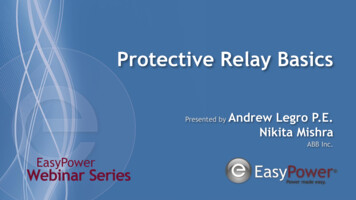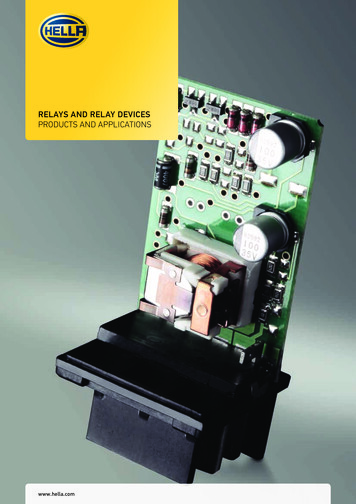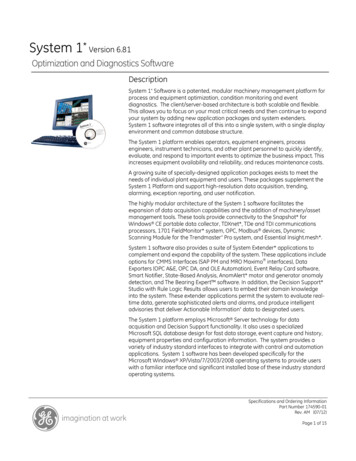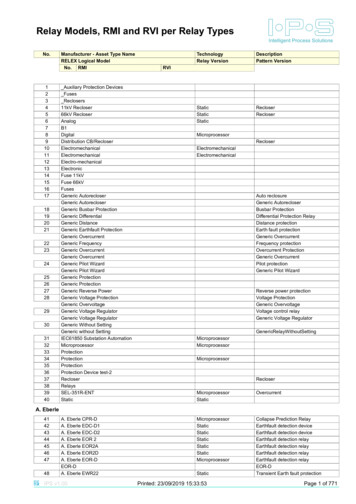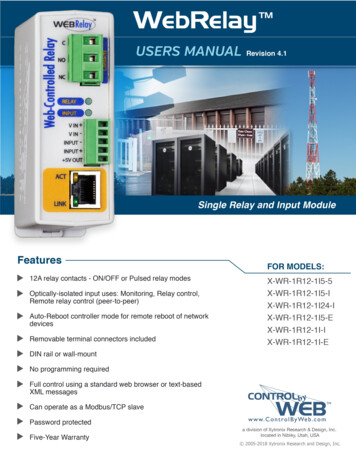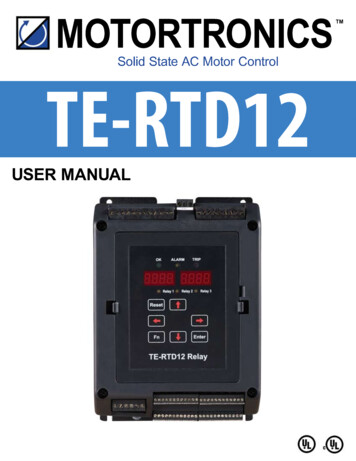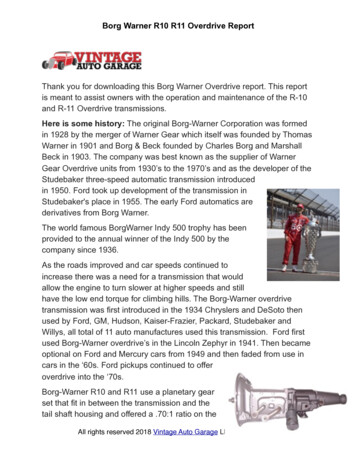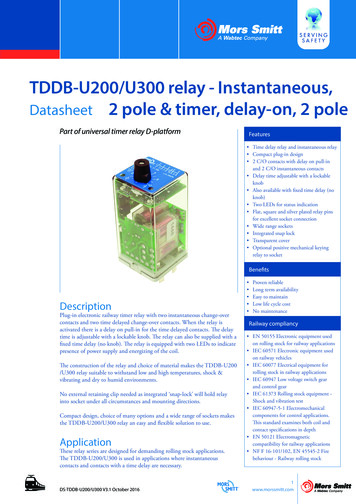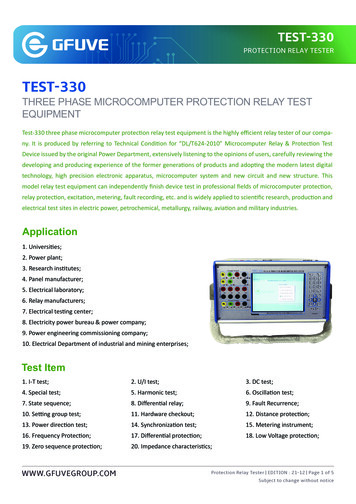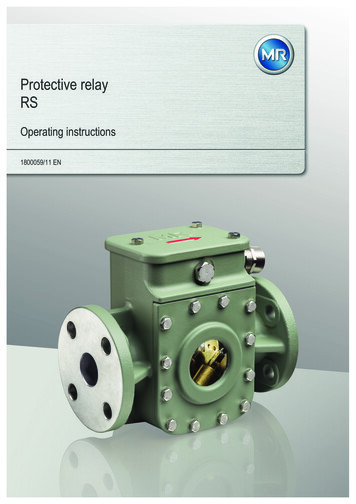
Transcription
Protective relayRSOperating instructions1800059/11 EN
All rights reserved by Maschinenfabrik ReinhausenDissemination and reproduction of this document and use and disclosure of its content are strictly prohibitedunless expressly permitted.Infringements will result in liability for compensation. All rights reserved in the event of the granting of patents,utility models or designs.The product may have been altered since this document was published.We reserve the right to change the technical data, design and scope of supply.Generally the information provided and agreements made when processing the individual quotations and ordersare binding.The original operating instructions were written in German.
Table of contentsTable of contents1Introduction. 51.1Validity . 51.2Manufacturer. 51.3Completeness. 51.4Safekeeping. 61.5Notation conventions . 61.5.1Hazard communication system . 61.5.2Information system. 71.5.3Instruction system . 72Safety. 92.1Appropriate use . 92.2Fundamental safety instructions . 92.3Personnel qualification. 112.4Personal protective equipment . 122.5Drying transformer . 132.5.1Drying transformer in furnace. 132.5.2Drying the transformer in the transformer tank . 133Product description. 143.1Scope of delivery . 143.2Function description. 143.3Design/versions . 153.4Nameplate . 173.5Safety markings . 174Packaging, transport and storage . 184.1Packaging . 184.1.1Suitability. 184.1.2Markings. 194.2Transportation, receipt and handling of shipments. 204.3Storage of shipments. 214.4Unpacking shipments and checking for transportation damages . 22Maschinenfabrik Reinhausen GmbH 20211800059/11 ENRS3
Table of contents5Mounting . 235.1Installing protective relay in piping and connecting . 235.1.1Electrical protection. 235.1.2Checking function of protective relay . 245.1.3Installing protective relay in piping . 275.1.4Making the electrical connections for the protective relay. 305.2Checking protective relay . 365.2.1Checking protective relay (RS 2001, 2001/V, 2001/H, 2001/E, 2001/5, 2001/R, 2001/T, 2003) . 365.2.2Checking protective relay (RS 2004) . 366Commissioning. 377Operation. 387.1Tripping the protective relay and re-commissioning the transformer. 387.1.1Flap valve in OPERATION position . 387.1.2Flap valve in OFF position . 397.1.3Re-commissioning the transformer . 398Maintenance. 408.1Inspection . 419Disposal. 4210Technical data for protective relay . 4310.1Protective relay with CO change-over contact as tripping switch . 4610.2Protective relay with several dry-reed magnetic switches . 4610.3Tests . 47Glossary . 484RS1800059/11 ENMaschinenfabrik Reinhausen GmbH 2021
1 Introduction1 IntroductionThis technical file contains detailed descriptions on the safe and proper installation, connection, commissioning and monitoring of the product.It also includes safety instructions and general information about the product.This technical file is intended solely for specially trained and authorized personnel.1.1 ValidityThis technical file applies to the following types of the protective relay: RS 2001 (standard design) RS 2001/V (seals made from Viton) RS 2001/H (for high oil conservators) RS 2001/E (increased protection from vibration) RS 2001/R (extra inspection window) RS 2003 (design for Canada) RS 2004 (design for Canada with automatic reset)1.2 ManufacturerThe product is manufactured by:Maschinenfabrik Reinhausen GmbHFalkensteinstraße 893059 RegensburgTel.: ( 49) 9 41/40 90-0E-mail: sales@reinhausen.comFurther information on the product and copies of this technical file are available from this address if required.1.3 CompletenessThis technical file is incomplete without the supporting documents.The following documents are considered supporting documents: Supplements (included in the scope of delivery) Dimensional drawing (included in the scope of delivery) Routine test report (included in the scope of delivery)Also observe generally valid legislation, standards, and guidelines as well asspecifications on accident prevention and environmental protection in the respective country of use.Maschinenfabrik Reinhausen GmbH 20211800059/11 ENRS5
1 Introduction1.4 SafekeepingKeep this technical file and all supporting documents ready at hand and accessible for future use at all times.1.5 Notation conventions1.5.1 Hazard communication systemWarnings in this technical file are displayed as follows.1.5.1.1 Warning relating to sectionWarnings relating to sections refer to entire chapters or sections, sub-sections or several paragraphs within this technical file. Warnings relating tosections use the following format:WARNINGType of danger!Source of the danger and outcome. Action Action1.5.1.2 Embedded warning informationEmbedded warnings refer to a particular part within a section. These warnings apply to smaller units of information than the warnings relating to sections. Embedded warnings use the following format:DANGER! Instruction for avoiding a dangerous situation.1.5.1.3 Signal words and pictogramsThe following signal words are used:Signal wordDefinitionDANGERIndicates a hazardous situation which, if not avoided, will result indeath or serious injury.WARNINGIndicates a hazardous situation which, if not avoided, could resultin death or serious injury.CAUTIONIndicates a hazardous situation which, if not avoided, could resultin minor or moderate injury.NOTICEIndicates measures to be taken to prevent damage to property.Table 1: Signal words in warning notices6RS1800059/11 ENMaschinenfabrik Reinhausen GmbH 2021
1 IntroductionPictograms warn of dangers:PictogramDefinitionWarning of a danger pointWarning of dangerous electrical voltageWarning of combustible substancesWarning of danger of tippingWarning of danger of crushingTable 2: Pictograms used in warning notices1.5.2 Information systemInformation is designed to simplify and improve understanding of particularprocedures. In this technical file it is laid out as follows:Important information.1.5.3 Instruction systemThis technical file contains single-step and multi-step instructions.Single-step instructionsInstructions which consist of only a single process step are structured as follows:Maschinenfabrik Reinhausen GmbH 20211800059/11 ENRS7
1 IntroductionAim of actionü Requirements (optional). Step 1 of 1.ð Result of step (optional).ð Result of action (optional).Multi-step instructionsInstructions which consist of several process steps are structured as follows:Aim of actionü Requirements (optional).1. Step 1.ð Result of step (optional).2. Step 2.ð Result of step (optional).ð Result of action (optional).8RS1800059/11 ENMaschinenfabrik Reinhausen GmbH 2021
2 Safety2 Safety Read this technical file through to familiarize yourself with the product. This technical file is a part of the product. Read and observe the safety instructions provided in this chapter. Read and observe the warnings in this technical file in order to avoid function-related dangers. The product is manufactured on the basis of state-of-the-art technology.Nevertheless, risks to life and limb for the user or impairment of the product and other material assets due to the function may arise in the event ofimproper use.2.1 Appropriate useThe product is designed solely for use in electrical energy systems and facilities. If used as intended and in compliance with the requirements and conditions specified in this technical file as well as the warning notices in this technical file and attached to the product, then the product does not present anydanger to people, property or the environment. This applies throughout theservice life of the product, from delivery, installation and operation to removal and disposal.The following is considered appropriate use: Use the product only with the on-load tap-changer and transformer specified in the order. The serial numbers of on-load tap-changer and on-load tap-changer accessories (drive, drive shaft, bevel gear, protective relay, etc.) must matchif the on-load tap-changer and on-load tap-changer accessories are supplied as a set for one order. Operate the product in accordance with this provided technical file, theagreed delivery conditions and technical data. Ensure that all necessary work is performed by qualified personnel only. Only use the equipment and special tools included in the scope of deliveryfor the intended purpose and in accordance with the specifications of thistechnical document.2.2 Fundamental safety instructionsTo prevent accidents, disruptions and damage as well as unacceptable adverse effects on the environment, those responsible for transport, installation, operation, maintenance and disposal of the product or parts of the product must ensure the following:Maschinenfabrik Reinhausen GmbH 20211800059/11 ENRS9
2 SafetyPersonal protective equipmentLoosely worn or unsuitable clothing increases the danger of becomingtrapped or caught up in rotating parts and the danger of getting caught onprotruding parts. This poses a danger to life and limb. Wear appropriate personal protective equipment such as a helmet, workgloves, etc. for the respective activity. Never wear damaged personal protective equipment. Never wear rings, necklaces, or other jewelry. If you have long hair, wear a hairnet.Work areaUntidy and poorly lit work areas can lead to accidents. Keep the work area clean and tidy. Make sure that the work area is well lit. Observe the applicable laws for accident prevention in the relevant country.Protection against electric shockIf the terminal box cover of the protective relay hangs from the wire on theside of the enclosure, this can lead to damage to the wires. This poses adanger to life and limb. Always remove the terminal box cover with wire from the protective relayfor any work which involves opening the protective relay. Remove the slotted head screw for potential tie-in and remove the terminal box cover with wire.Working during operationThe product may only be operated in a sound, operational condition. Otherwise it poses a danger to life and limb. Regularly check the operational reliability of safety equipment. Comply with the inspection work, maintenance work and maintenance intervals described in this technical file.Explosion protectionHighly flammable or explosive gases, vapors and dusts can cause seriousexplosions and fire. This increases the danger to life and limb. Do not install, operate or perform maintenance work on the product in areas where a risk of explosion is present.10RS1800059/11 ENMaschinenfabrik Reinhausen GmbH 2021
2 SafetySafety markingsWarning signs and safety information plates are safety markings on theproduct. They are an important aspect of the safety concept. Observe all safety markings on the product. Make sure all safety markings on the product remain intact and legible. Replace safety markings that are damaged or missing.Ambient conditionsTo ensure reliable and safe operation, the product must only be operatedunder the ambient conditions specified in the technical data. Observe the specified operating conditions and requirements for the installation location.Auxiliary materials and operating materialsAuxiliary materials and operating materials not approved by MaschinenfabrikReinhausen GmbH can lead to personal injuries, damage to the product andproduct malfunctions. Only use conductive and grounded hoses, pipes, and pump equipmentthat are approved for flammable liquids. Only use lubricants and auxiliary materials approved by the manufacturer. Contact Maschinenfabrik Reinhausen GmbH.Modifications and conversionsUnauthorized or inappropriate changes to the product may lead to personalinjury, material damage and operational faults. Only modify the product after consultation with the manufacturer.Spare partsSpare parts not approved by the manufacturer may lead to physical injury,damage to the product and operational faults. Only use spare parts approved by the manufacturer. Contact the manufacturer.2.3 Personnel qualificationThe person responsible for assembly, commissioning, operation, maintenance and inspection must ensure that the personnel are sufficiently qualified.Maschinenfabrik Reinhausen GmbH 20211800059/11 ENRS11
2 SafetyElectrically skilled personThe electrically skilled person has a technical qualification and therefore hasthe required knowledge and experience, and is also conversant with the applicable standards and regulations. The electrically skilled person is also proficient in the following: Can identify potential dangers independently and is able to avoid them. Is able to perform work on electrical systems. Is specially trained for the working environment in which (s)he works. Must satisfy the requirements of the applicable statutory regulations foraccident prevention.Electrically trained personsAn electrically trained person receives instruction and guidance from anelectrically skilled person in relation to the tasks undertaken and the potential dangers in the event of inappropriate handling as well as the protectivedevices and safety measures. The electrically trained person works exclusively under the guidance and supervision of an electrically skilled person.OperatorThe operator uses and operates the product in line with this technical file.The operating company provides the operator with instruction and trainingon the specific tasks and the associated potential dangers arising from improper handling.Technical ServiceWe strongly recommend having maintenance, repairs and retrofitting carriedout by our Technical Service department. This ensures that all work is performed correctly. If maintenance is not carried out by our Technical Servicedepartment, please ensure that the personnel who carry out the maintenance are trained and authorized by Maschinenfabrik Reinhausen GmbH tocarry out the work.Authorized personnelAuthorized personnel are trained by Maschinenfabrik Reinhausen GmbH tocarry out special maintenance.2.4 Personal protective equipmentPersonal protective equipment must be worn during work to minimize risks tohealth. Always wear the personal protective equipment required for the job athand. Never wear damaged personal protective equipment. Observe information about personal protective equipment provided in thework area.12RS1800059/11 ENMaschinenfabrik Reinhausen GmbH 2021
2 SafetyProtective clothingClose-fitting work clothing with a low tearing strength,with tight sleeves and with no protruding parts. It mainlyserves to protect the wearer against being caught bymoving machine parts.Safety shoesTo protect against falling heavy objects and slipping onslippery surfaces.Safety glassesTo protect the eyes from flying parts and splashing liquids.VisorTo protect the face from flying parts and splashing liquids or other dangerous substances.Hard hatTo protect against falling and flying parts and materials.Hearing protectionTo protect against hearing damage.Protective glovesTo protect against mechanical, thermal, and electricalhazards.Table 3: Personal protective equipment2.5 Drying transformer2.5.1 Drying transformer in furnaceObserve the following information when drying the transformer in a furnace.NOTICEDamage to protective relay, on-load tap-changer and transformer!If the protective relay is dried in a furnace, this may cause damage to theprotective relay and restrict its correct function. Do not dry protective relay in a furnace.2.5.2 Drying the transformer in the transformer tankIf drying takes place in the transformer tank, the protective relay can remainfitted during the drying process.Maschinenfabrik Reinhausen GmbH 20211800059/11 ENRS13
3 Product description3 Product description3.1 Scope of deliveryThe product is packaged with protection against moisture and is delivered asfollows: Protective relay Technical filesPlease note the following: Check the shipment for completeness on the basis of the shipping documents. Store the parts in a dry place until installation The product must remain in its airtight, protective wrapping and may onlybe removed immediately before installation3.2 Function descriptionThe protective relay is looped into the circuit breaker tripping circuit. It istripped when the specified speed of flow from the on-load tap-changer headto the oil conservator is exceeded due to a fault. The flowing insulating fluidactuates the flap valve which tips over into position OFF. The contact in thedry-reed magnetic switch is thereby actuated, the circuit breakers aretripped, and the transformer is de-energized.The protective relay is a component of an on-load tap-changer filled with insulating fluid and its properties conform to the respective applicable versionof IEC publication 60214-1.Diverter switch operations at rated switching capacity or at permissible overload will not cause the protective relay to trip.The protective relay responds to flow, not to gas accumulated in the protective relay. It is not necessary to bleed the protective relay when filling thetransformer with insulating fluid. Gas accumulation in the protective relay isnormal.14RS1800059/11 ENMaschinenfabrik Reinhausen GmbH 2021
3 Product description3.3 Design/versionsFront viewFigure 1: Protective relay RS 20011 Inspection window2 Pressure equalization elementRear viewFigure 2: Protective relay RS 20011 Dummy plug2 NameplateThe protective relay RS 2001/R has an extra inspection window on the rear.Maschinenfabrik Reinhausen GmbH 20211800059/11 ENRS15
3 Product descriptionView from aboveFigure 3: Protective relay RS 20011 Gasket2 Potential tie-in3 Terminal box cover4 Slotted head screw for potentialtie-in5 OPERATION (reset) test button6 Slotted head screw for protectivecover7 OFF (test tripping) test button8 Cable gland9 Protective cover11 Connection terminal10 Dummy plug12 Pressure equalization element13 Cylinder head screw for protectiveconductor connectionThe protective relays RS 2003 and RS 2004 have a 1/2"-14NPT adapter inplace of the cable gland.16RS1800059/11 ENMaschinenfabrik Reinhausen GmbH 2021
3 Product description3.4 NameplateThe nameplate is on the back of the protective relay.Figure 4: Nameplate3.5 Safety markingsThe following safety markings are used on the product:Figure 5: Safety markings overview1 Protective conductor connection2 Warning of dangerous electricalvoltage3 Read the documentationMaschinenfabrik Reinhausen GmbH 20211800059/11 ENRS17
4 Packaging, transport and storage4 Packaging, transport and storage4.1 PackagingThe products are sometimes supplied with sealed packaging and sometimesin a dry state, depending on requirements.Sealed packaging surrounds the packaged goods with plastic foil on allsides.Products that have also been dried are identified by a yellow label on thesealed packaging. In the dry state, delivery is also possible in a transportcontainer.The information in the following sections should be applied as appropriate.4.1.1 SuitabilityNOTICEProperty damage due to incorrectly stacked crates!Stacking the crates incorrectly can lead to damage to the packaged goods. The outer marking on the packaging states if, for example, the on-loadtap-changer or selector has been packed upright. Never stack thesecrates. General rule: Do not stack crates above a height of 1.5 m. For other crates: Only stack up to 2 equally sized crates on top of one another.The packaging is suitable to ensure undamaged and fully functional meansof transportation in compliance with local transportation laws and regulations.The packaged goods are packed in a sturdy crate. This crate ensures that,when in the intended transportation position, the packaged goods are stabilized to prevent impermissible changes in position, and that none of the partstouch the loading surface of the means of transport or touch the ground afterunloading.18RS1800059/11 ENMaschinenfabrik Reinhausen GmbH 2021
4 Packaging, transport and storage4.1.2 MarkingsThe packaging bears a signature with instructions for safe transport and correct storage. The following symbols apply to the shipment of non-hazardousgoods. Adherence to these symbols is mandatory.Protect againstmoistureTopFragileAttach liftinggear hereCenter of massTable 4: Shipping pictogramsMaschinenfabrik Reinhausen GmbH 20211800059/11 ENRS19
4 Packaging, transport and storage4.2 Transportation, receipt and handling of shipmentsWARNINGDanger of death or severe injury!Danger of death or serious injuries due to tipping or falling load. Only transport the crate when closed. Do not remove the securing material used in the crate during transport. If the product is delivered on a pallet, secure it sufficiently. Only trained and authorized persons may select the sling gear and secure the load. Do not walk under the suspended load. Use means of transport and lifting gear with a sufficient carrying capacityin accordance with the weight stated on the delivery slip.In addition to oscillation stress, jolts must also be expected during transportation. In order to prevent possible damage, avoid dropping, tipping,knocking over and colliding with the product.If a crate tips over, falls from a certain height (e.g. when slings tear) or issubject to an unbroken fall, damage must be expected regardless of theweight.Every delivered shipment must be checked for the following by the recipientbefore acceptance (acknowledgment of receipt): Completeness based on the delivery slip External damage of any typeThe checks must take place after unloading when the crate or transport container can be accessed from all sides.Visible damage If external transport damage is found upon receipt of the shipment, proceedas follows: Immediately record the identified transport damage in the shipping documents and have this countersigned by the carrier. In the event of severe damage, total loss or high damage costs, immediately notify the manufacturer and the relevant insurance company. After identifying damage, do not modify the condition of the shipment further and retain the packaging material until an inspection decision hasbeen made by the transport company or the insurance company. Record the details of the damage immediately on site together with thecarrier involved. This is essential for any claim for damages. Photograph damage to packaging and packaged goods. This also appliesto signs of corrosion on the packaged goods due to moisture inside thepackaging (rain, snow, condensation). NOTICE! Damage to packaged goods due to damaged sealed packaging. If the product is delivered in sealed packaging, check the sealedpackaging immediately. If the sealed packaging is damaged, do not under20RS1800059/11 ENMaschinenfabrik Reinhausen GmbH 2021
4 Packaging, transport and storageany circumstances install or commission the packaged goods. Either redry the dried packaged goods as per the operating instructions, or contactthe manufacturer to agree on how to proceed. Identify the damaged parts.Hidden damage When damages are not determined until unpacking after receipt of the shipment (hidden damage), proceed as follows: Make the party responsible for the damage liable as soon as possible bytelephone and in writing, and prepare a damage report. Observe the time periods applicable to such actions in the respectivecountry. Inquire about these in good time.With hidden damage, it is very hard to make the transportation company (orother responsible party) liable. Any insurance claims for such damages canonly be successful if relevant provisions are expressly included in the insurance terms and conditions.4.3 Storage of shipmentsPackaged goods dried by Maschinenfabrik ReinhausenUpon receipt of the shipment, immediately remove the packaged goodsdried by Maschinenfabrik Reinhausen from the sealed packaging and storeair-tight in dry insulating fluid until used if the packaged goods were not supplied in insulating fluid.Non-dried packaged goodsNon-dried packaged goods but with a f
If the terminal box cover of the protective relay hangs from the wire on the side of the enclosure, this can lead to damage to the wires. This poses a danger to life and limb. Always remove the terminal box cover with wire from the protective relay for any work which involves opening the protective relay.

